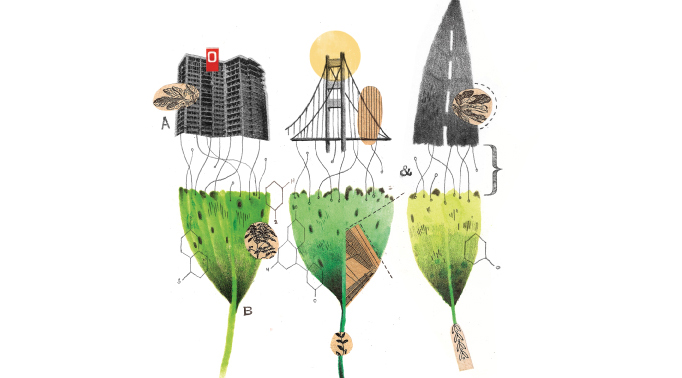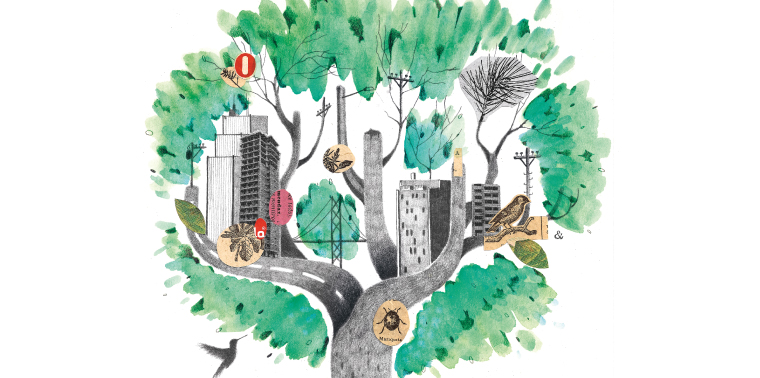January 29, 2013 — We humans are problem solvers. We’re doers. We encounter challenges and complicated situations and we find ways to surmount them—crafting tools, erecting bridges, programming computers. We’ve innovated and designed our way out of countless predicaments and, dammit, we will forevermore.
We are also hopelessly arrogant.
See, we humans sometimes forget that we are not the only innovators and designers out there. We’re not the only ones able to creatively adapt our way through tricky or threatening conditions. We forget about nature.
Long before we showed up on the scene, there were wetlands that made dirty water clean, prairies that grew sustainable food crops and termites that built living spaces capable of maintaining a nearly steady internal temperature year round. These and other natural systems, developed over thousands or millions of years, are amazingly adept at dealing with the sort of logistical concerns humans face every day—whereas many of the workarounds we’ve found for the problems of our lives are inefficient or overly expensive or carry on the oh-so-human tradition of causing more problems than they solve.
Luckily, we’ve also managed to learn that sometimes the best way to solve a problem is to borrow somebody else’s good idea.
Enter biomimicry—the idea of emulating strategies nature has perfected. By looking closely at natural processes and organisms, we can identify and learn from some of the ways nature solves the problems that challenge us. And the closer we look, the more of these solutions we find. Many of these nature-inspired solutions have implications for that most human of habitats: the city. From stronger building materials to more intuitive water systems, biomimicry has applications in urban infrastructure that can dramatically improve the way we live in cities.
Cities as Ecosystems
In her landmark 1997 book Biomimicry: Innovation Inspired by Nature, biologist Janine Benyus presents elegant examples of ways in which the natural world offers very clear hints about how to improve elements of our human world, such as how spider silk can inform the engineering of super-strong materials and how plants can teach us better ways to harvest energy from the sun. That book is now required reading for engineers, environmental scientists, industrial designers and practitioners of countless other disciplines.
“Nature is really a master example of making different things work one to the other and eliminating things that don’t fit with the picture.”
To spread these ideas into the real world, Benyus created a consulting firm now called Biomimicry 3.8—as in 3.8 billion years of research and design done for us already by nature. Biomimicry 3.8 biologists and designers work with groups and companies all over the world to try to inject some of the lessons of nature into their products and services. They’ve helped major apparel companies, airplane makers, hospitals and furniture designers.
The lessons of nature, Benyus says, apply widely across the spectrum. Even to entire cities.
“Actually, architects and city planners were the first audience to really embrace the book,” Benyus says.

Illustration by Samuel Castano
That might seem surprising at first. But in many ways, urban areas are like ecosystems. They have interconnected components such as buildings, streets and sewer systems that are themselves complex—like birds, orchids and insects all living within the framework of a tree. This sort of systems thinking is crucial for cities. Running cities that are efficient and equitable requires being able to see, for example, how water systems react to population growth or how the extent of a transportation network determines energy use and development patterns. Like nature, all these elements are connected.
More and more, biomimicry is being thought of as a way to reconsider the ways we build and operate cities.
“You don’t design a set of roads in isolation but in relation to buildings, but also to the sewer system below or to the cabling,” says Ilaria Mazzoleni, an architect and professor at the Southern California Institute of Architecture who’s been teaching and working with the concept of biomimicry in architecture for nearly 10 years. “There are a lot of invisible elements that go into it. And nature is really a master example of making different things work one to the other and eliminating things that don’t fit with the picture.”
Mazzoleni says this type of thinking is becoming more prevalent. True biomimicry, she argues, considers an object or building or infrastructure as part of a much larger system. Cities, therefore, are the perfect arena for biomimetic design. And given the vast amounts of aging and crumbling infrastructure in urban areas around the world, there’s plenty of work to be done.
Ensia shares solutions-focused stories free of charge through our online magazine and partner media. That means audiences around the world have ready access to stories that can — and do — help them shape a better future. If you value our work, please show your support today.
Yes, I'll support Ensia!

Have read a tiny bit about bio-mimicry in the past, but nice to learn more about how it's developing in the here and now.
Thanks!
Dr. Korkmaz would be a great asset to get as a professor at a US University.
Another example of biomimetic thinking applied to urban planning is the emerging field of "urban metabolism" -- which looks at the flows of water, waste, and other nutrients through urban ecosystems. A great application of this approach is the design of Lloyd Crossing by Mithun Architects Designers + Planners, in which the design team compared flows of water, carbon, etc. against a "pre-development baseline."
My colleague Lyle Solla-Yates and I have also used this approach in our research, for instance investigating the impact of alternative waste management systems: http://www.carlsterner.com/research/2010_toward_the_green_city.shtml